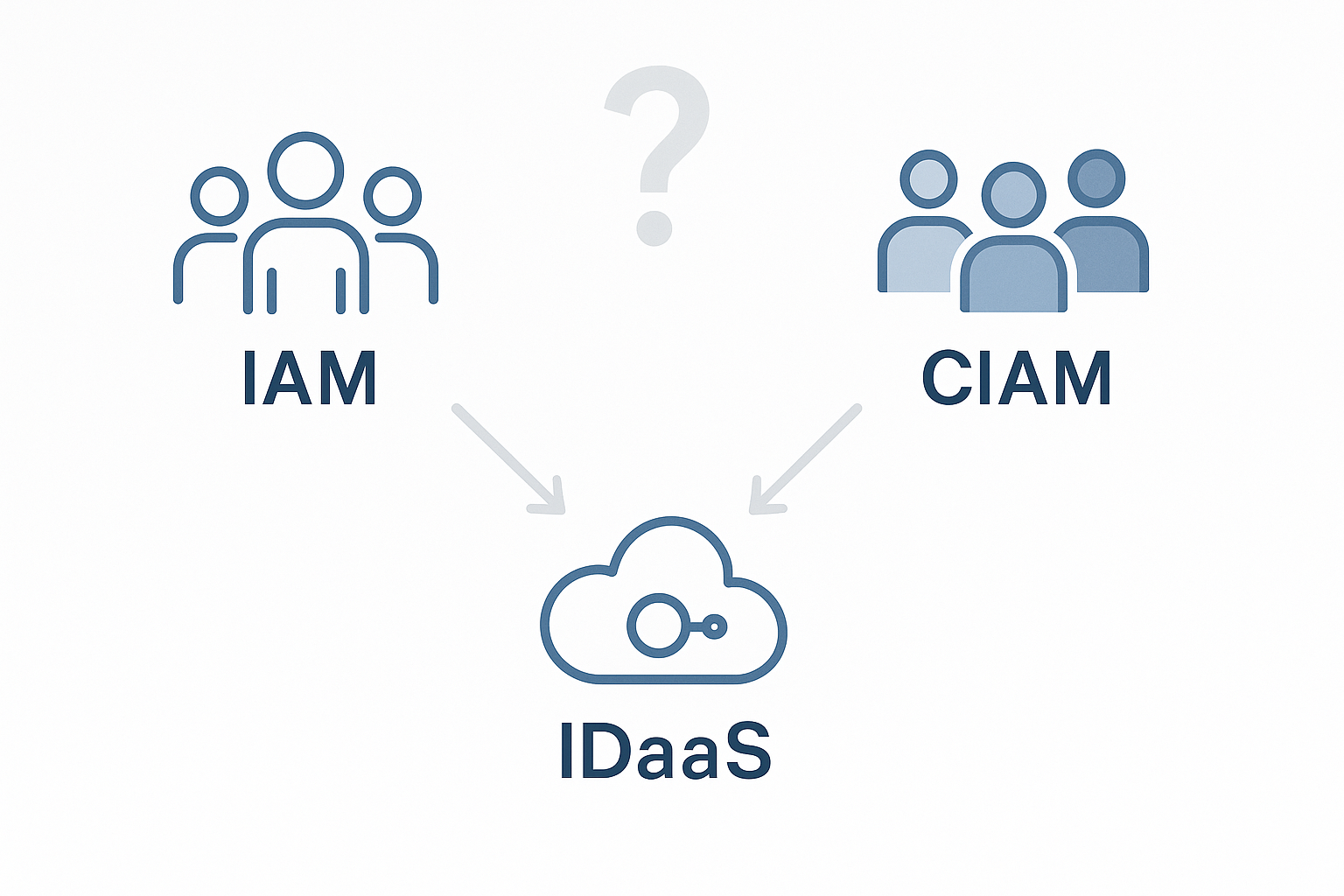Understanding Identity Management: IAM, CIAM, and IDaaS Explained
Confused by IAM, CIAM, and IDaaS? This guide breaks down the key differences to help you choose the right identity solution for your business.

Identity management has become critical for modern businesses. Companies need to control who accesses their systems and data. Three terms dominate this space: IAM, CIAM, and IDaaS. Many people use these terms interchangeably, but they serve different purposes.
Understanding these differences helps you choose the right solution for your business needs.
The Foundation: Identity and Access Management (IAM)
IAM started as the original identity solution. Companies built these systems to manage their employees and internal users. Think of IAM as the digital equivalent of office keycards and security badges.
Traditional IAM focuses on workforce identity. When Sarah from accounting needs access to the payroll system, IAM handles that request. When John from IT requires admin privileges for the server room, IAM manages those permissions too.
IAM systems typically include several core components. Directory services store user information and credentials. Single sign-on lets employees access multiple applications with one login. Role-based access control assigns permissions based on job functions. Privileged access management handles high-level administrative accounts.
Most IAM solutions assume users work within a trusted environment. Employees connect from corporate networks or VPN connections. This assumption shapes how these systems handle security and user experience.
The user experience in traditional IAM prioritizes functionality over convenience. Employees expect some friction when accessing sensitive business systems. Complex password requirements and multi-step authentication processes are acceptable trade-offs for security.
The Evolution: Customer Identity and Access Management (CIAM)
CIAM emerged when companies realized that managing customer identities requires different approaches than employee management. Customers have different expectations, different security requirements, and different usage patterns.
Customer identity management faces unique challenges. Millions of users might register for your service rather than hundreds of employees. Customers expect seamless experiences similar to consumer applications they use daily. They abandon services that create friction during registration or login.
Privacy regulations like GDPR and CCPA added complexity to customer identity management. Companies must obtain explicit consent for data collection. They need mechanisms for users to view modify, and delete their personal information. Traditional IAM systems were not designed for these requirements.
CIAM solutions address these specific customer-focused needs. They handle massive scale registration and authentication. Social login options let customers use existing accounts from Google, Facebook, or other platforms. Progressive profiling collects customer information gradually rather than requiring lengthy registration forms.
Customer data management becomes central in CIAM. These systems track customer preferences, communication consent, and behavioral data. They integrate with marketing automation platforms and customer relationship management tools.
Security approaches differ significantly between employee and customer identity systems. CIAM solutions must assume that customer devices and networks are potentially compromised. They implement adaptive authentication that adjusts security requirements based on risk factors.
The user experience in CIAM prioritizes convenience while maintaining security. Customers expect quick registration, password reset options and smooth login experiences across devices. Friction during these processes directly impacts business metrics like conversion rates and customer satisfaction.
The Delivery Model: Identity-as-a-Service (IDaaS)
IDaaS represents how identity services are delivered rather than what they do. This model provides identity capabilities through cloud-based subscription services instead of on-premises software installations.
Traditional identity systems required significant infrastructure investments. Companies purchased servers, installed software, and maintained complex deployments. IDaaS eliminates these requirements by delivering identity services through the internet.
Cloud delivery offers several advantages for identity management. Automatic updates ensure systems stay current with security patches and new features. Scalability becomes seamless as usage grows or shrinks. Geographic distribution improves performance for global organizations.
IDaaS platforms can provide IAM capabilities, CIAM functions, or both. The delivery model is independent of the identity use case being addressed. Some IDaaS providers focus on workforce identity, others specialize in customer identity, and some offer comprehensive platforms covering both areas.
Cost structures change with IDaaS adoption. Instead of large upfront software licenses and hardware investments companies pay subscription fees based on usage. This shift transforms identity management from a capital expense to an operational expense.
Integration patterns also differ with cloud-delivered identity services. IDaaS solutions typically offer REST APIs and standard protocols like SAML and OAuth. These modern integration approaches work well with cloud-native applications and microservices architectures.
Distinguishing the Differences
The primary distinction between IAM and CIAM lies in their target users and use cases. IAM manages internal users like employees, contractors and business partners. CIAM handles external users including customers, prospects, and end consumers.
Scale requirements separate these approaches significantly. IAM typically handles hundreds or thousands of users. CIAM must support millions of user accounts and high-volume authentication requests.
User experience expectations create another major difference. Employee users accept more complex authentication processes for accessing business systems. Customer users expect consumer-grade experiences that prioritize convenience and speed.
Compliance requirements differ between employee and customer identity management. IAM focuses on internal security policies and regulations like SOX compliance. CIAM must address privacy regulations, data protection laws, and consumer rights.
Integration patterns vary based on the target use case. IAM integrates with enterprise applications, directory services, and business productivity tools. CIAM connects with customer-facing applications marketing platforms, and e-commerce systems.
IDaaS differs from both IAM and CIAM because it describes service delivery rather than functionality. IDaaS can deliver workforce identity capabilities, customer identity features, or comprehensive platforms addressing both needs.
Choosing the Right Approach
Understanding your primary use case helps determine which solution fits your needs. Organizations managing employee access should focus on IAM capabilities whether delivered on-premises or through IDaaS.
Companies building customer-facing applications need CIAM functionality. The massive scale, user experience requirements and privacy compliance needs make specialized customer identity solutions necessary.
Many modern organizations require both workforce and customer identity management. Some IDaaS platforms provide comprehensive solutions covering both use cases. Others specialize in one area and integrate with complementary solutions.
Budget considerations influence deployment decisions. IDaaS reduces upfront costs and infrastructure requirements but creates ongoing operational expenses. On-premises solutions require larger initial investments but may cost less over time for stable deployments.
Technical capabilities within your organization affect implementation approaches. IDaaS solutions require less internal expertise for deployment and maintenance. On-premises identity systems need dedicated technical resources for installation, configuration, and ongoing management.
Compliance requirements may limit deployment options. Some regulations require data to remain within specific geographic regions or organizational boundaries. These constraints might favor on-premises deployments or specific cloud providers.
Implementation Considerations
Successful identity management implementations require careful planning regardless of the chosen approach. Start by identifying all user types that need access to your systems. Map out the applications and data each user group requires.
Security requirements vary based on the sensitivity of protected resources. Financial applications need stronger authentication than marketing websites. Customer-facing applications balance security with user experience requirements.
Integration complexity increases with the number of applications and systems involved. Modern identity solutions use standard protocols to simplify connections but legacy applications may require custom integration work.
Data migration becomes critical when replacing existing identity systems. User accounts, permissions, and historical data must transfer to new platforms without disrupting operations.
Change management helps ensure successful adoption of new identity systems. Employees need training on updated login processes. Customers require communication about account changes or new features.
The Future of Identity Management
Identity management continues evolving as technology advances and security threats change. Biometric authentication becomes more common for both employee and customer applications. Behavioral analytics help detect suspicious access patterns.
Zero-trust security models assume that no user or device should be automatically trusted. This approach increases the importance of strong identity verification and continuous monitoring.
Artificial intelligence enhances identity security through improved risk assessment and anomaly detection. Machine learning algorithms can identify unusual access patterns that might indicate compromised accounts.
Privacy regulations continue expanding globally creating new requirements for customer identity management. Organizations must design systems that protect user privacy while enabling business operations.
The distinction between IAM, CIAM, and IDaaS will likely remain relevant as each addresses different aspects of identity management. Understanding these differences helps organizations build comprehensive identity strategies that support both security and business objectives.
Organizations succeed when they match their identity solutions to their specific requirements rather than adopting generic approaches. The right identity management strategy protects sensitive resources while enabling seamless user experiences for both employees and customers.

